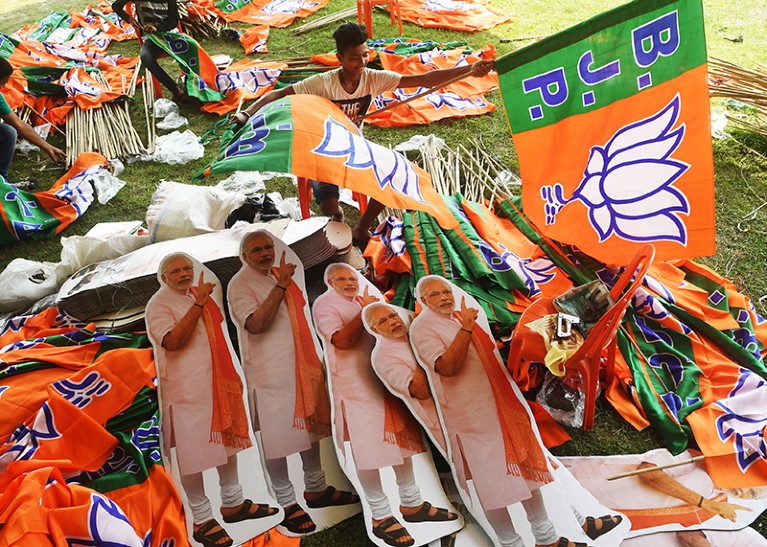
Preparations for a rally in favour of Indian Prime Minister Narendra Modi in Kolkata in April 2019.Credit: Dibyangshu Sarkar/AFP/Getty
Holy Science: The Biopolitics of Hindu Nationalism Banu Subramaniam Univ. Washington Press (2019)
The British quit India in 1947. A blood-soaked partition had torn the subcontinent into two states that became the Islamic Republic of Pakistan and the Republic of India, the latter comprising many faiths but secular. Or attempting to be: India was left with not so much a separation of state and religion as an intention to embrace all traditions evenly.
Yet, since the 1990s, Hindu nationalism has steadily gathered strength in India. In 2014, the Bharatiya Janata Party gained a parliamentary majority for the first time, with Narendra Modi as prime minister. The party was re-elected in 2019, with a larger margin of the vote — 37.5%. A notable aspect of the party’s nationalist narratives is the meshing of science, pseudoscience and myth with political messages. Now, these entangled narratives are explored in Holy Science by Banu Subramaniam, a scholar of women, gender and sexuality studies.
This form of nationalism has found favour, she argues, by reinforcing an alluring idea of an India rooted in an ancient civilization where science, technology and philosophy thrived; an India that can be restored to grandeur by linking to its past. Subramaniam writes that this idea has led to a “scientized religion” and a “religionized science”, creating “a vision of India as an archaic modernity”.
India is hardly alone in its tendency to fuse tradition with politics. Across the border in Pakistan, lawmaking is based on a particular interpretation of Islamic belief. And in the United States, a strand of conservatism has long mingled with Christian fundamentalism and the rejection of evolution. But as the examples in Holy Science show, the burgeoning complexity of this fusion in India is notable.
Evolving society: why humanity coheres
Ancient India abounded in scientific advances, in fields from astronomy and mathematics to metallurgy and surgery. The Sanskrit text Sushruta Samhita, dated to the first millennium bc, discusses techniques for skin grafts and nose reconstruction. These achievements, along with traditional Indian knowledge systems, were egregiously sidelined during colonial rule. Yet some nationalist rhetoric overstates or distorts history. Subramaniam shows how modern science has been bolted to Hindu mythology: Modi has posited, for example, that the elephant-headed deity Ganesha was a product of ancient cosmetic surgery. Other claims have been made for the current relevance of ancient practices. For instance, Modi has made speeches declaring that yoga can help tackle climate change by nurturing a social conscience.
At the heart of Holy Science are several case studies examining the interplay of biology, public policy and ancient traditions in today’s India, which Subramaniam frames as “bionationalism”. One is the marketing of vaastu shaastra, literally the ‘science of architecture’, a tradition not unlike Chinese feng shui that originated in the Vedas — the earliest Hindu scriptures, dating back more than three millennia. This belief system holds that siting rooms and entrances in certain ways bestows harmony and encourages well-being. Architects sometimes feel commercial pressure to offer ‘vaastu-compliant’ structures, and it is common practice in cities such as Bengaluru and Mumbai to remodel existing buildings.
Several elected officials in recent years have been finicky about the vaastu of their offices. Subramaniam even notes that, in 2015, the chief minister of Telangana state, K. Chandrasekhar Rao, hired his vaastu consultant as a governmental “advisor on architecture”. Now, the state’s secretariat is to be demolished to make way for a new, vaastu-compliant one.
Another of Subramaniam’s examples reveals that scientific and religious aims can merge, arguably more positively. The government-driven Sethusamudram Shipping Canal Project, which launched in 2005, aimed to dredge a passage through limestone shoals between islands off the coasts of India and Sri Lanka. Environmental scientists who protested against the destruction of this fragile ecosystem found themselves on the same side as Hindu leaders who see the site as sacred (the shoals feature in the epic poem the Ramayana, as a bridge built by the deity Rama and his army of monkeys). Ultimately, the Archaeological Survey of India, the supreme court and the parliament were drawn into the debate. Work on the project halted in 2009.
Subramaniam also examines how scientific studies can be used or misused to shape perceptions about belief systems and culture. A case in point is the Aryan migration theory, which posits that the originators of Vedic culture — a significant component of Hinduism — dispersed into India around 4,000 years ago. Many nationalists, who believe that the roots of Hinduism are vastly more ancient, have claimed that genetic research has debunked the theory. But, increasingly, studies such as a 2017 meta-analysis do point to relevant influxes around four millennia ago (M. Silva et al. BMC Evol. Biol. 17, 88; 2017).
Subramaniam’s discussions are rich, nuanced and alive to the complex, overlapping ways in which science, caste, class, patriarchy, colonialism and capitalism shape politics and culture in India. Holy Science draws from a range of scholarship, while being aware that much of it emanates from values centred in Europe and the Enlightenment. The book could have benefited from engaging with more contemporary discourse in regional Indian languages, including writing by and around four thinkers and writers whose assassinations in the past few years have been linked to the more violent fringes of Hindu nationalism. Journalist Gauri Lankesh, physician and social activist Narendra Dabholkar, politician Govind Pansare and academic M. M. Kalburgi all worked in either Kannada, spoken mainly in the state of Karnataka, or Marathi, the official language of Maharashtra. It is in such regional languages that the fiercest battles around Indian identity seem to take place.
Holy Science is also experimental. Subramaniam leavens her academic text with interludes of speculative fiction centred on an imaginary planet, whose inhabitants evolve towards celebrating difference, fluidity, playfulness and justice. Her writing here is similar in texture to stories from the Indian epics and Puranas, a great body of classical literature mainly in Sanskrit, which have at times been invoked to narrow political ends. By reminding us of the capacious spirit in these works, Subramaniam seeks to reclaim them.
More urgently, Holy Science illuminates how science is spun at a time when India faces enormous social and economic challenges. With heatwaves and water shortages signposting intensifying climate change, with farmers protesting against worsening conditions, and children dying from lack of basic health interventions, a forking path lies ahead. Can an India in thrall to the narratives of nationalism foster a rigorous, clear-eyed reckoning of its situation, or does it see only what it wants to see?

 Evolving society: why humanity coheres
Evolving society: why humanity coheres








